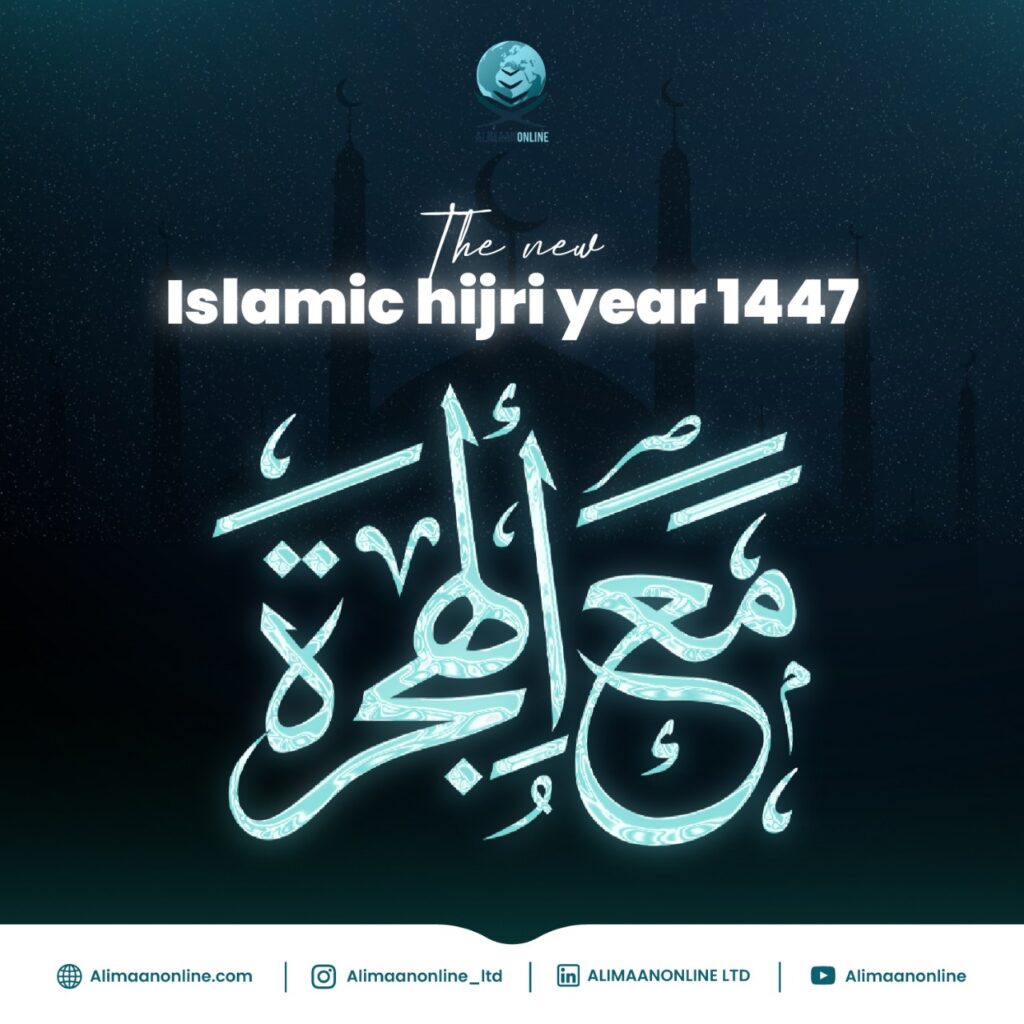The new Islamic Hijri year is a moment of spiritual reflection that begins with the sacred month of Muharram, the first in the Islamic calendar.
It serves as a time to renew intentions, remember historical sacrifices, and realign our lives with the teachings of Islam.
While the Gregorian New Year focuses on worldly goals, the new Islamic Hijri year encourages spiritual growth and divine connection.
When Does the New Islamic Hijri Year 2025 Begin?
The new Islamic Hijri year 1447 AH (After Hijrah) will begin at sunset on Friday, June 27, 2025, and continue through Saturday, June 28, 2025.
This date marks 1 Muharram 1447, the first day of the Islamic calendar, as scholars determine it based on the lunar cycle, not the solar year.
Because the Islamic calendar is 10 to 12 days shorter than the Gregorian one, the new Islamic Hijri year moves earlier every year.
This natural shift reminds Muslims of the fleeting nature of time and the importance of using each year wisely in worship.
The Origin of the New Islamic Hijri Year: A Legacy of Sacrifice and Faith
The new Islamic Hijri year begins with the remembrance of the Hijrah — the historic migration of Prophet Muhammad ﷺ from Makkah to Madinah.
This event was more than a physical journey; it marked the beginning of a new phase in Islamic civilization.
The Prophet ﷺ and Abu Bakr (RA) faced danger, traveled secretly, and hid in the Cave of Thawr before reaching safety.
Upon reaching Madinah, the first Islamic state was formed, and Islam was practiced openly for the first time in history.
Years later, during the caliphate of Umar ibn Al-Khattab (RA), the companions chose this migration as the starting point of the Islamic calendar.
Thus, the new Islamic Hijri year commemorates not just a date, but a story of resilience, divine trust, and new beginnings.
Why Muharram Matters in the New Islamic Hijri Year
Muharram is the first of the four sacred months and holds immense spiritual value in Islam. It sets the tone for the new Islamic Hijri year.
The 10th day of this month, known as Ashura, is remembered for two significant events in Islamic history.
Firstly, Allah saved Prophet Musa (AS) and his followers from Pharaoh. Secondly, Imam Hussain (RA) and his family were martyred in Karbala.
The Prophet ﷺ encouraged fasting on Ashura, stating that it expiates the sins of the past year.
Therefore, the new Islamic Hijri year begins with a reminder of both triumph through faith and the value of standing for justice.
The Story Behind the Hijrah: A Defining Moment of the New Islamic Hijri Year
The new Islamic Hijri year is deeply rooted in the Hijrah — the Prophet Muhammad’s ﷺ historic migration from Makkah to Madinah.
This migration wasn’t merely a physical relocation. It marked the transformation of Islam from a persecuted belief to a global movement.
The story of the Hijrah begins with the intense persecution that Muslims faced in Makkah after the Prophet ﷺ began preaching Islam.
Early followers, including slaves and the poor, were tortured, boycotted, and killed for their belief in Allah and His Messenger.
Despite the hardships, the Prophet ﷺ remained in Makkah for 13 years, calling people to tawheed (monotheism) and justice.
Eventually, Allah gave him permission to migrate, which became the pivotal event honored by the new Islamic Hijri year.
The Secret Plan and the Cave of Thawr
The Quraysh leaders in Makkah became increasingly hostile, fearing the spread of Islam and loss of their political dominance.
They plotted to assassinate the Prophet ﷺ by choosing one warrior from each tribe to strike him simultaneously in the night.
However, Jibreel (AS) warned the Prophet ﷺ about the plan. He then instructed his cousin Ali ibn Abi Talib (RA) to sleep in his bed.
This act of bravery bought the Prophet ﷺ enough time to escape. He left silently and met Abu Bakr (RA), his closest companion.
Together, they left Makkah and took shelter in the Cave of Thawr, located south of the city, hiding there for three days.
During that time, the Quraysh searched desperately for them. They even reached the mouth of the cave but failed to see inside.
A spider had spun a web and a dove nested at the cave’s entrance — divine signs that Allah was protecting His Messenger.
This miraculous moment reflects why the new Islamic Hijri year is a symbol of divine support and unwavering trust in Allah.
The Journey to Madinah and a New Beginning
After the danger passed, the Prophet ﷺ and Abu Bakr (RA) took a longer, unfamiliar route toward Madinah to avoid detection.
They were guided by a non-Muslim expert in navigation named Abdullah ibn Urayqit, showing how strategy and trust coexisted.
On their way, several people tried to capture the Prophet ﷺ for the reward, including a man named Suraqah ibn Malik.
When Suraqah approached them, his horse mysteriously sank into the ground, and he realized this was a protected Messenger of Allah.
Eventually, the Prophet ﷺ reached Quba, a village near Madinah, where he built the first mosque — Masjid Quba — before entering the city.
Upon arriving in Madinah, the people welcomed him with joy, singing “Tala‘a al-Badru ‘alayna”, expressing love and devotion to their new leader.
This migration laid the foundation for the first Islamic state, governed by justice, unity, and submission to Allah’s law.
Therefore, the new Islamic Hijri year marks not just the start of a calendar but the birth of a powerful Islamic civilization.
The Historical Impact of the Hijrah on the Ummah
The Hijrah teaches countless lessons about leadership, sacrifice, brotherhood, and the importance of building community based on faith.
When Prophet Muhammad ﷺ reached Madinah, he united the Muhajirun (migrants from Makkah) with the Ansar (helpers of Madinah).
This brotherhood created a strong, supportive Muslim community, and ended years of tribal rivalries that divided Arabia.
The Prophet ﷺ also drafted the Constitution of Madinah, which ensured peace, justice, and religious freedom for Muslims and non-Muslims alike.
This political wisdom and inclusive governance shaped the Islamic model for centuries, beginning with the event honored by the new Islamic Hijri year.
Why the Hijrah Was Chosen to Begin the New Islamic Hijri Year
Years after the Prophet ﷺ passed away, during the caliphate of Umar ibn Al-Khattab (RA), the Muslim state needed a unified calendar.
Scholars and companions discussed which date should mark the beginning of this calendar — the birth, prophethood, or migration of the Prophet.
They agreed that the Hijrah was the most significant, as it marked Islam’s transition from a persecuted message to a victorious movement.
Hence, 1 Muharram 1 AH (After Hijrah) became the first day of the Islamic calendar — and the start of the new Islamic Hijri year.
How Muslims Celebrate the New Islamic Hijri Year Around the World
Though not celebrated with festivities like Eid, the new Islamic Hijri year is observed with spiritual reflection and increased acts of worship.
In many Muslim-majority countries, scholars give sermons, families gather to recount stories from the Hijrah, and children learn about Muharram.
Mosques often host special events, and Islamic centers promote prayer, fasting, and charity to mark the occasion.
The focus of the new Islamic Hijri year is always inward — aiming to strengthen the soul rather than the body.
The Spiritual Goals Muslims Set in the New Islamic Hijri Year
As the new Islamic Hijri year arrives, Muslims set spiritual resolutions to strengthen their connection with Allah
These resolutions may include improving one’s salah (prayers), memorizing more Quran, giving regular sadaqah (charity), or seeking forgiveness more frequently.
Setting realistic, faith-driven goals allows individuals to transform their hearts gradually and with purpose.
The beauty of the new Islamic Hijri year lies in the opportunity to reset without waiting for external change — only sincere effort matters.
The Deeper Meaning of the Hijrah in the New Islamic Hijri Year
The Hijrah wasn’t just about escaping danger — it was a journey of conviction, planning, and deep reliance on Allah’s will.
When the Prophet ﷺ left Makkah, he was leaving behind wealth, homeland, and even family, for the sake of protecting the message of Islam.
That’s why the new Islamic Hijri year reminds Muslims annually of the importance of faith over fear and trust over comfort.
The lessons of Hijrah — resilience, brotherhood, migration for faith, and establishing justice — are as relevant now as they were in 622 CE.
How to Teach Children About the New Islamic Hijri Year
Raising awareness about the new Islamic Hijri year among children helps develop pride in Islamic identity and encourages love for sacred traditions.
Parents and educators can use books, coloring sheets, storytelling, and interactive lessons to teach children the story of the Hijrah.
This not only enhances their historical knowledge but also strengthens their spiritual foundation and love for the Prophet ﷺ.
Celebrating the new Islamic Hijri year with your children can also become a family tradition that builds memories and moral lessons.
Starting the New Islamic Hijri Year with Du’a and Good Intentions
The Prophet ﷺ taught us that “actions are judged by intentions.” Therefore, it is vital to start the new Islamic Hijri year with sincere niyyah.
One should make du’a asking Allah to bless the coming year, forgive past mistakes, and make us better Muslims.
It’s also wise to review one’s deeds, seek forgiveness from others, and plan new routines that include regular remembrance of Allah.
Starting the new Islamic Hijri year with strong intentions brings barakah, clarity, and purpose into our lives for the months to follow.
Time, Accountability, and the New Islamic Hijri Year
Islam teaches that time is among our most valuable resources. The Quran swears by time, and the Prophet ﷺ warned against wasting it.
The arrival of the new Islamic Hijri year signals that yet another year has passed — and that we are one year closer to the Hereafter.
It is a moment to ask: What have I achieved spiritually this past year? Have I come closer to Allah or drifted away?
The new Islamic Hijri year invites this deep reflection so that we do not meet our Lord without preparing our hearts and actions.
Conclusion: Embracing the New Islamic Hijri Year with Gratitude and Purpose
The new Islamic Hijri year is not just a date on the calendar; it is a spiritual gift, a divine opportunity, and a historical reminder.
It calls on Muslims everywhere to reflect on the Hijrah, honor the month of Muharram, and renew their dedication to Islam.
Through du’a, intention, charity, and education, the year can begin in a way that pleases Allah and enriches the soul.
Let us enter the new Islamic Hijri year 1447 AH with gratitude in our hearts and sincerity in our actions, striving for a better self.

